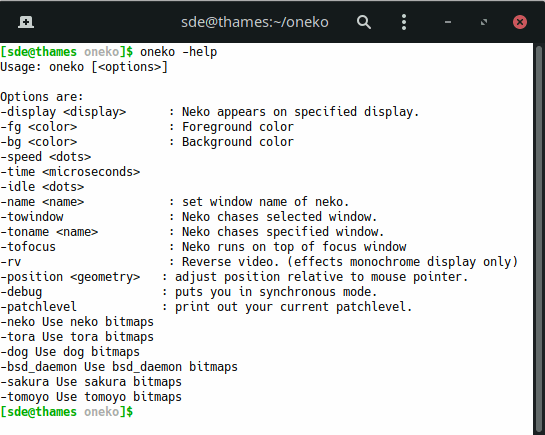Last Updated on May 25, 2022
Who loves eye candy? Don’t be shy — you can raise both hands!!
Linux Candy is a series of articles covering interesting eye candy software. We’re only featuring open-source software in this series.
If you spend all day embroiled in political in-fighting, battling red tape nonsense, coding an innovative program in Python, sit in countless meetings wishing you were relaxing on a Caribbean island, you’ll need some light relief at the end of the day. And what better way by making your desktop environment a bit more fun.
You couldn’t get anything more candy like than oneko, a program that creates a cat chasing after your mouse cursor. Makes me want to watch some Tom & Jerry cartoons.
Installation
There’s a package in the Arch User Repository for Arch-based distros. I haven’t checked out other distributions, but compiling is trivial in any event.
$ git clone https://github.com/tie/oneko.git
$ cd oneko
$ clang -Wno-parentheses -std=c11 -pedantic -D_DEFAULT_SOURCE oneko.c -o oneko -lc -lm -lX11 -lXext
In Operation
So what does oneko do? By default, it creates a little cat which chases after your mouse cursor.
When the cat catches up with the mouse cursor, it stares at the screen, scratches an annoying itch on its body. The cat then proceeds to yawn (after all, it’s tiring chasing around a mouse), and falls asleep until the mouse cursor moves.

There’s a few options, as detailed in the screenshot above.
The interesting options change the cat to a Sakura Kinomoto, Tomoyo Daidouji, a dog, and even a BSD daemon.
Summary
oneko is a harmless, even frivolous piece of fun. If it brightens up your day, it’s achieved its goal.
The word “neko” means “cat” in Japanese. The program was created by a Japanese author as a Macintosh desktop accessory, but has seen a number of forks.
Website: www.daidouji.com/oneko
Support: GitHub Code Repository
Developer: Tatsuya Kato, based on “xneko” written by Masayuki Koba, and modified by many other people
License: Open Source
oneko is written in C. If you’re looking to improve your knowledge of this language, check out our recommended free C books and free C tutorials.
Complete list of articles in this series:
| Linux Candy | |
|---|---|
| ASCIIQuarium | Embrace marine life from the terminal with beautiful ASCII art |
| ASCII Art Converter | A small utility that converts images into ASCII art |
| BobRossQuotes | Collection of quotes from Bob Ross |
| Boxes | Command line ASCII boxes |
| Buoh | Online strips comics reader |
| cacafire | Color ASCII fire |
| catclock | xclock with an enhanced cat mode |
| cbonsai | Generate bonsai trees in the terminal |
| christmasfetch | Festive cheer on the desktop |
| chucknorris | Chuck Norris jokes in your terminal |
| cornyjokes | Corny jokes for the terminal |
| CMatrix | ncurses program that simulates the display from “The Matrix” |
| ctree | A Christmas tree right on your terminal |
| eDEX-UI | Sci-fi computer terminal emulator and system monitor |
| emoj | Simple tool that to find suitable emojis for pasting to your clipboard |
| Emote | Modern popup emoji picker |
| Evolvotron | Interactive generative art |
| Fantascene | Dynamic wallpaper changer |
| Fondo | Find beautiful wallpapers from Unsplash |
| gti | Typo-based curio inspired by Steam Locomotive |
| Hollywood | Fill your console with Hollywood melodrama technobabble |
| lifecycler | Aquarium right in your terminal |
| linuxwave | Generate music from the entropy of Linux |
| lolcat | Rainbows and unicorns |
| Meme | Fun tool to create memes |
| No More Secrets | Recreates the data decryption effect from the Sneakers movie |
| nook | Plays Animal Crossing hourly themes on the hour |
| nyancat | Terminal-based Pop Tart Cat Animation |
| oneko | Animal chasing fun |
| pipes.sh | Animated pipes terminal screensaver |
| ponysay | cowsay reimplemention for ponies |
| projectM | Music visualizer originally based on Milkdrop |
| pscircle | A different take on the venerable ps command |
| PyBonsai | Generates procedural ASCII art trees |
| pyjokes | One line jokes for programmers |
| Pywal | Generate color schemes on the fly (not actively developed) |
| Relaxator | Relax to soothing sounds |
| Rusty Aquarium | Monitoring by visualization |
| Steam Locomotive | C program written in 295 lines. It's harmless fun |
| Ternimal | Animated lifeform in the terminal |
| terminal-parrot | Party parrot time |
| tetris | Tile-matching puzzle video game in your terminal |
| Variety | Wallpaper manager with many desktops and wallpaper sources |
| WallGen | Generate HQ poly wallpapers with a few arguments. |
| WallpaperDownloader | Download, change, and manage wallpapers |
| wallust | Create 16 color palettes |
| xcowsay | Displays a cow on your desktop with message |
| XDecorations | Add some festive cheer to your desktop |
| XScreenSaver | Framework and collection of screensavers |
| yosay | Like cowsay but with less cow |

wow that’s really cool I might do this on my terminal as well.
I had oneko last month for 2 days. I had to turn it off as during scrolling when mouse cursor is on oneko, the virtual desktops are change. First day I did not understand what was going on and that my Mint went crazy, but finally found out that the change happens when mouse cursor is over oneko and I scroll (either way). So I had to turn oneko off as this way its almost unusable for me, for example you read some text, then want to scroll down/up, but unfortunatelly move the cursor a bit over a sleeeping oneko and bum, you are in a different desktop. But I have to finally find the settings for this and turn off desktop changes through mouse scroll (as I do not use it anyway) and turn oneko back on as its really cute 🙂
clang -Wno-parentheses -std=c11 -pedantic -D_DEFAULT_SOURCE oneko.c -o oneko -lc -lm -lX11 -lXext
result: clang: error: no such file or directory: ‘oneko.c’
Don’t forget to change into the oneko directory first.